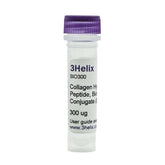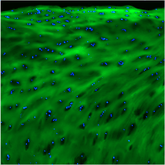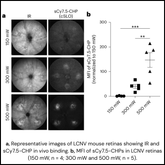How Collagen Hybridizing Peptides Reveal Hidden Molecular Damage Behind Back Pain
Hundreds of millions of people suffer from chronic back pain, often stemming from Degenerative Disc Disease (DDD). MRI imaging can visualize the structural decay of spinal discs, but what if DDD pathogenesis starts long before gross morphological degeneration is identified?
For years, researchers have hypothesized that the real issues begin on the molecular level when the collagen in our discs begins to degrade. But without the proper tools to directly visualize (let alone measure) this damage, researchers have been left with a critical gap in their understanding of DDD. Studying molecular collagen damage has been a massive challenge. While standard histology techniques can show tissue disorganization and anti-collagen antibodies can highlight collagen content, neither method can specifically differentiate healthy tissue from damage. Our Collagen Hybridizing Peptides (CHPs) can close this gap.
A study published in the Journal of Orthopedic Research utilized CHPs on human spinal disc tissue collected from patients undergoing surgery for severe DDD. Unlike traditional methods, CHPs are engineered to selectively bind to damaged collagen molecules to provide direct, quantifiable readouts of pathophysiological tissue damage, remodeling, and repair. CHPs’ unique features allowed researchers to get the clear, quantitative evidence they were looking for.
Continue Reading
By utilizing our Biotin-conjugated CHP, researchers could:
- Selectively identify DDD damage. Collagen Hybridizing Peptides highlighted areas of molecular damage, clearly distinguishing diseased discs from the healthy control samples exhibiting minimal binding.
- Quantify differences. Not only did CHPs selectively highlight damage, their signal is quantifiable, allowing researchers to show a dramatic, statistically significant increase in molecular damage in DDD samples.
CHPs provided the quantitative evidence that researchers needed to confirm molecular collagen damages as a key feature of DDD. Thanks to CHPs, long-held hypotheses like these can finally be measured.
By providing a tool that can selectively measure molecular collagen damage, CHPs have unlocked a deeper understanding of the mechanisms behind chronic back pain. Even beyond DDD, this study serves as a powerful demonstration for any scientist studying conditions involving tissue degradation. Whether it's arthritis, fibrosis, or cardiovascular disease, CHPs offer a clear, quantitative way to assess the molecular integrity of tissues, opening up new avenues for diagnostics, drug development, and understanding the very foundation of disease dynamics.





























